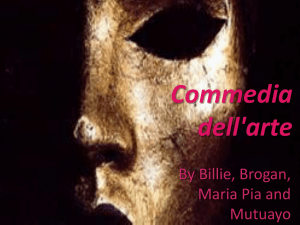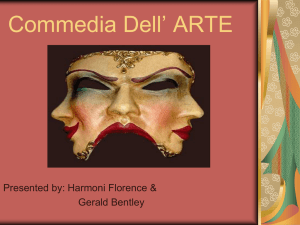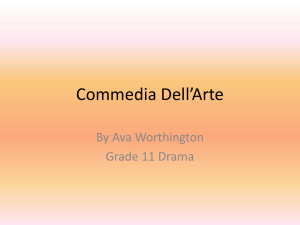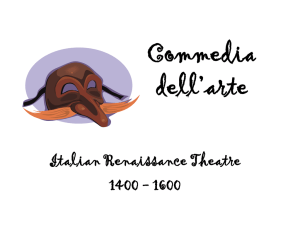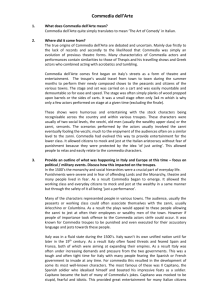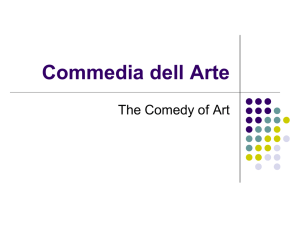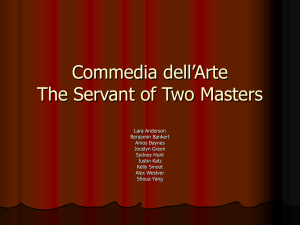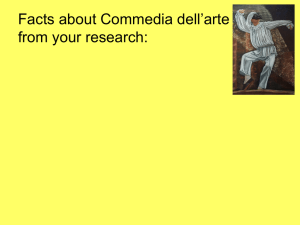Commedia Dell`Arte Unit of Lessons.Cali Wilkes
advertisement
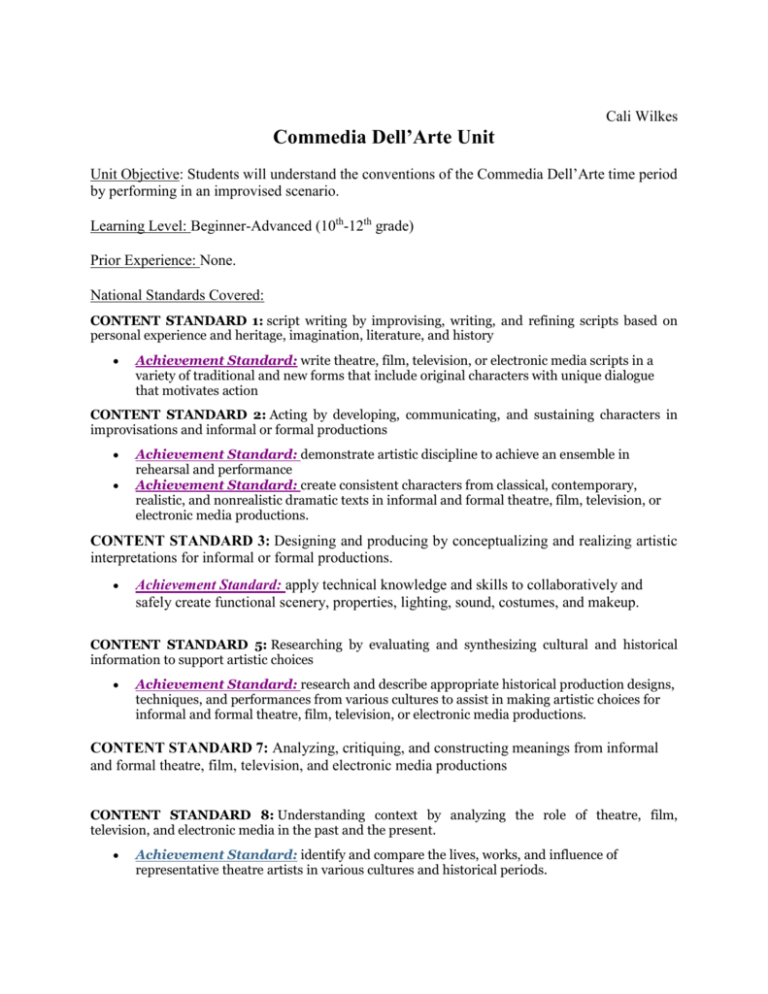
Cali Wilkes Commedia Dell’Arte Unit Unit Objective: Students will understand the conventions of the Commedia Dell’Arte time period by performing in an improvised scenario. Learning Level: Beginner-Advanced (10th-12th grade) Prior Experience: None. National Standards Covered: CONTENT STANDARD 1: script writing by improvising, writing, and refining scripts based on personal experience and heritage, imagination, literature, and history Achievement Standard: write theatre, film, television, or electronic media scripts in a variety of traditional and new forms that include original characters with unique dialogue that motivates action CONTENT STANDARD 2: Acting by developing, communicating, and sustaining characters in improvisations and informal or formal productions Achievement Standard: demonstrate artistic discipline to achieve an ensemble in rehearsal and performance Achievement Standard: create consistent characters from classical, contemporary, realistic, and nonrealistic dramatic texts in informal and formal theatre, film, television, or electronic media productions. CONTENT STANDARD 3: Designing and producing by conceptualizing and realizing artistic interpretations for informal or formal productions. Achievement Standard: apply technical knowledge and skills to collaboratively and safely create functional scenery, properties, lighting, sound, costumes, and makeup. CONTENT STANDARD 5: Researching by evaluating and synthesizing cultural and historical information to support artistic choices Achievement Standard: research and describe appropriate historical production designs, techniques, and performances from various cultures to assist in making artistic choices for informal and formal theatre, film, television, or electronic media productions. CONTENT STANDARD 7: Analyzing, critiquing, and constructing meanings from informal and formal theatre, film, television, and electronic media productions CONTENT STANDARD 8: Understanding context by analyzing the role of theatre, film, television, and electronic media in the past and the present. Achievement Standard: identify and compare the lives, works, and influence of representative theatre artists in various cultures and historical periods. Enduring Understandings -In the process of studying and analyzing the different components of the Commedia Dell’Arte time period in history the students will be better able to understand the influences this time period has on theater and comedy today by analysis and compare and contrast. Essential Questions What influences does Commedia Dell’Arte have on society today? What are different examples of modern stock characters? What is the importance of working together as a team? What makes a good performance? What bearing can research and contextualization have on character development? How does your objective inform your choices? How do you maintain a physically and emotionally safe environment in your classroom? How can an actor apply, in real life, the historical information gained into a live performance? Lesson 1-Intro to Commedia Learning Objective-The students will be able to demonstrate their knowledge of Commedia Del’Arte by participating in a Jeopardy game. CONTENT STANDARD 8: Understanding context by analyzing the role of theatre, film, television, and electronic media in the past and the present. Achievement Standard: identify and compare the lives, works, and influence of representative theatre artists in various cultures and historical periods. Level- Drama 3 (11th and 12th graders) Materials Needed- Whiteboard, copies of Commedia Del’Arte pictures, tape, copies of Commedia History Handout, computer (internet to access www.nationaltheater.org.uk) HookHave written on the board what has came out of Italy? Once the students come in invite the students to come up to the board and write down their thoughts. (Spaghetti, Fast cars, Catholics, Pope) Discuss each of the things that were written on the board. Add if not written Commedia Del’ Arte, Commedia Del’ Arte originated in Italy in the 1500’s. Step One-Discussion Before the students enter the room, tape up pictures of different Commedia characters around the room. Once the discussion of what comes out of Italy have the class walk around the room and look at each of the pictures. Tell the student, as you are looking at each of these pictures take notice of things that stick out to you—we are going to share with the class. Step Two-Transition Gather the group back together once they have looked at all of the pictures. Ask the class what were things that stuck out to them? What did they have questions about? What seemed odd? Have the students discuss this with a partner near them. Once the conversation dies down tell the class to remember what questions you have and make sure they get answered in this next activity. Step Three- Instruction Have the class get into groups of three. Each member of the group is responsible for researching a different element of Commedia history. PERSON ONE-Origins of Commedia Del’ Arte- This should include where it began, when it began, who participated, description of commedia, and how they performed. PERSON TWO- Purpose of Commedia Dell Arte – This should include why it was started, why they chose the format/venues that they did and how they performed PERSON THREE- · Influence of Commedia Dell Arte – This should include other countries that it has spread to, writers it has influenced, plays it has influenced and other types of theatre it has influenced. Step Four- Group Work Have all the number one’s, two’s, and three’s get into groups. If the groups are big create smaller groups within the same number for easier flow. Use the history background sheet and make sure you are prepared to share with your group. Work together with the people who are your same number to find all the information you need to know. Give the students 10 minutes to gather all the information they need to know. Step Five- Peer Teaching Have the students get back into their original groups, one of each number in each group, and share what they have learned. Give each of the students 2 minutes to share. After each person presents the other two students can ask them any questions they have. Have each number, one, two and three present. Step Six-Discussion/Checking for Understanding Gather the class all together. You now have a glimpse into the world of Commedia Del’ Arte. Ask the class who can tell me something interesting you learned from a member of your group? Have students share. Step Seven Show the clip from the National Theater website entitled “A Brief History of Commedia”. That was your final review. www.nationaltheater.org.uk Now let’s compete. Step Eight-Assessment Now to test our knowledge we are going to play Jeopardy. The normal Jeopardy rules apply. You must answer each question with “What is” if you do not you will get it wrong. I have twelve questions. Whoever answers the most correct wins! Ask for 5 volunteers. The winner of the first question stays and the losers sit down and the next group of students come up and challenge him on the next question. Repeat this until every person has tried to answer a question and all of the questions have been answered. ASSESSMENT: Students will show their knowledge of Commedia Del’ Arte by participating in a Jeopardy game. SUPPLEMENTS: History of Commedia Worksheet, Pictures of Commedia Del’ Arte History of Commedia Taken from the websites: http://www.answers.com/topic/commedia-dell-arte & http://www.american.edu/IRVINE/jenn/home.html www.american.edu/IRVINE/jenn/home.html Commedia dell'Arte, Italian for play of professional artists, was a popular form of entertainment in Italy during the Renaissance (the height of its popularity was from 1550 to 1750). From Italy, Commedia gained great popularity in other European countries, especially in France. Commedia companies usually included ten actors--seven men and three women. (It should be noted that this is at the same time as William Shakespeare is writing his plays for an all male cast.) These performers played for the public in open town squares. There were no scripts, only written scenarios (in Italian, canovaccios) which outlined the action. Using these sketches, the actors improvised the dialogue and action, tailoring the show to that day's audience. The actors in a Commedia troupe each focus on one character, who they play for the rest of their lives. These characters were stock types, meaning that the same characters appeared in every show. Each character had its own bit of lazzi, or business, which the audience would instantly recognize. Focusing on one character allows an actor to fuse his or her own personality with that of the individual they are playing. And, since the actors worked in close quarters for an extended period of time, they grew used to each others' portrayals. This allowed for easy improvisation and skillful comic interaction on the spur of the moment. Commedia dell'Arte has had a distinct influence on comedy since its beginning. After its adoption in France, the effect was obvious in many plays, most notably those of Moliere. In his comedy Tartuffe, Moliere included the classic Commedia scenario involving a father arranging his daughter in a marriage to a man much older than she is. The daughter is, of course, already in love with a man her own age. Several of Commedia's stock characters are also present in Tartuffe, including the innocent lovers and the smart, wise-talking servant. These characters have also been adapted in other countries. One example of this is the still popular Punch and Judy show in England. More recently, Commedia's influence can be seen in the Marx Brothers movies, where much of the action and dialogue is improvised. The brothers used standard lazzi and costumes, and fused them with their versions of the stock characters. Mainstream audiences of today can certainly recognize many of Commedia's stock characters in the cartoon The Simpsons. Homer, Bart, and Mr. Burns are all examples of these characters. http://www.answers.com/topic/commedia-dell-arte Commedia dell'arte (kōm-mā'dēä dĕl-lär'tā) , popular form of comedy employing improvised dialogue and masked characters that flourished in Italy from the 16th to the 18th cent. Influence The impact of commedia dell'arte on European drama can be seen in French pantomime and the English harlequinade. The ensemble companies generally performed in Italy, although a company called the comédie-italienne was established in Paris in 1661. The commedia dell'arte survived the early 18th cent. only by means of its vast influence on written dramatic forms. The commedia dell'arte, with its stock situations, stock characters and improvised dialogue spawned many other forms of drama, including pantomime and Punch and Judy. Quite notably, many if not the majority of comic plays from roughly the 16th-19th centuries have clear influences from the commedia dell'arte, including spinoffs from the traditional characters. Some examples include Shakespeare's The Tempest (play), with a fairly traditional commedia plot structure and Prospero matching up to the part of Il Dottore, and Ferdanand and Miranda as innamorati; Beaumarchais' Le Barbier de Séville, which features a traditional plot, innamorati (The Count and Rosine) the zanni Brighella (Figaro) and the vecchio Dottore (Doctor Bartholo); and Rostand's Cyrano de Bergerac, with Roxanne as innamorata and Cyrano as Il Capitano/innamorato. Molière was strongly influenced by commedia, as he had come in contact with travelling Italian actors in the provinces and worked alongside a troupe in Paris for two years. Harpagon in The Miser (1668) was modeled on Pantalone, and there are traces of other stock characters in Élise, Frosine, Valère, and La Flèche. The playwright was also a lead actor, and performed in the commedic style, with a love for physical humor. Aspects of commedia dell'arte also passed into the silent tradition of mime. The Bohemian actor Jean-Gaspard Deburau (1796 -1846) brought the new forms of mime to Paris in the 1830s. He standardized the French image of Pierrot. Bibliography See K. M. Lea, The Italian Popular Comedy (2 vol., 1934, repr. 1962); W. Smith, Commedia Dell'arte (rev. ed. 1964); P. L. Duchartre, The Italian Comedy (tr. 1928, repr. 1965); A. Nicoll, The World of Harlequin: A Critical Study of the Commedia dell'Arte (1987). JEOPARDY QUIZ 1) This is the time period when Commedia Dell Arte was most popular. What is the Renaissance? 2. These were the characters that appeared in every show. What are Stock characters? 3) This is the country where Commedia originated. Where is Italy? 4) This is the century when Commedia began. What is the 16th century? 5) This is the country outside of Italy that was most influenced by Commedia. What is France? 6) A typical Commedia troupe was composed of 7 of these and 3 of these. What are 7 men and 3 women? 7) This Shakespeare Play was influenced by Commedia. What is the Tempest? 8) This was the typical venue of a Commedia performance. What is an open town square? 9) This French playwright was greatly influenced by Commedia. Who is Moliere? 10) This form of acting without words derived from Commedia. What is Pantomime? 11) This performance technique, often created out of mid air, was used in dialogue for shows. What is Improvisation? 12) This pair of comedic brothers was influenced by Commedia. Who are the Marx Brothers? Lesson 2-Stock Characters Learning Objective-Students will be able to demonstrate their knowledge of stock characters by participating in an improvisation game. CONTENT STANDARD 2: Acting by developing, communicating, and sustaining characters in improvisations and informal or formal productions. Materials Needed- Copies of supplements, white board, white board marker, and slips of paper with different stock characters written on them, pictures of the different characters. HookWhen the students enter the room have a piece of paper with a stock character written on it under each persons chair (have a brief definition in case someone doesn’t know whose theirs is). Once everyone is present and announcements are through have them pull the paper out and start walking around the room as their character. As the students are walking around ask the following questions, what is your characters personality, loyalty, status, plot function? Once they have walked around for a few minutes gather the students together. Step One-Transition Ask the students what different types of people did you notice? List them off and have someone write them up on the whiteboard. (Villain, Hero, Damsel in Distress, Side kick, servant) Ask the class who has heard the word stock character and who can define it for me? As a class define what a stock character is. (character based off literary or social stereotypes) Step Two-Activity-Group Practice Divide the class into groups of five and assign each group a stock character and have them define what their key indicators are. (Posture, mannerisms, costume, interactions?) Once you have defined it give examples of characters from plays, TV shows, and plays that are your stock character. Once you have a solid idea of your character—have your whole group create a scene where you act out who your character is without words for the entire class. Then present any additional information about the character after the performance. Make sure every member participates. Step Three- Group Share Have each group present. The class will guess which stock character they are presenting on. Step Four- Discussion/ Checking for Understanding Discuss with the class how stock characters are all around us. In television, films, the stage, our community, Pleasant Grove high school, our drama classroom. Besides celebrities and famous fictional characters where do you see stock characters in your daily life? Step Four- Peer Teaching There are seven basic Commedia characters. Show a picture of each character with their name. Tell the kids to take notice of what the character looks like, what clothes does it wear, what does his mask look like, body posture? There are a lot but we are just focusing on these seven today. Each character has its own personality and role. Now come up to the front of the classroom and grab one hand out. There will be seven different piles. Once you have a handout read it. You will be an expert on this type of character. Expound further beyond what brief statement I just shared. After 3 minutes get with a partner who has a different character and teach each other about the character you have. Give the students 2 minutes for sharing. Then switch until each person has been taught about each type of character. If you are done before the two minutes are up go back with more detail until the time is up. 1. Pantolone—Merchant—afraid of losing his money 2. Dottore- Doctor 3. Arlecchino-A mischievous servant 4. Brighalla- Magician, Fortune Teller 5. Capitano- An arrogant egotistical man 6. Lovers 7. Zanni- Servant who never works—always eating or daydreaming When troupes would perform the combination of these characters created comedic moments. Step Five- Group Practice Tell the students we will be playing the game freeze with a little twist. Ask for two volunteers. Have them pick a stock character. Ask the class for a place and situation where they would interact. (breakup at the movie theater). Have the student improvise a scene in their character. After a little while invite the rest of the class to join the scene by yelling out FREEZE. When a new person enters the scene they must change the location and scenario by taking the persons exact position who they are replacing. Have multiple students participate in this activity. Step Six- Discussion After the class dies down bring everyone together. What did you just see? How did certain stock characters interact with each other? Were there some things that worked better than others? What did you find funny? Why? Did you see characteristics of the different Commedia characters in any of the scenes? Why do you suppose their characteristics translated over into these modern day examples? How do stock characters apply to you as theater practitioners today? Step Seven- Transition Remember the seven different types of characters you learned about today and what makes them unique. Next time we will be focusing on how they move and how their costume pieces distinguish them in their society and culture. ASSESSMENT: The students will show their knowledge of Commedia characters by participating in classroom activities/discussion as well as improvisation games. SUPPLEMENTS: Commedia Character Descriptions. ARLECCHINO STATUS: Arlecchino is a shape shifting servant to Pantalone, Il Capitano or Il Dottore. A crafty low status character, Arlecchino tries to trick his patrons out of money, but usually fails. Arlecchino is very quick, acrobatic and limber. He's not as intelligent as Brighella, but he is not as stupid as the Zannis. ORIGIN: There are many hypotheses as to the origin of Arlecchino's name. The most probable one is that Arlecchino is based on the myth of the 'damned devils' -Germanic knights that fought against the Normans and died. These warriors, it was believed, would rise from the dead to play tricks on the living. COSTUME: Arlecchino's costume is tight with multicolored patches in either symmetrical or random patterns. He wears a black belt and a slapstick. A slapstick is made from two thin strips of wood that are seperated by a half inch piece of wood connected to the handle. A loud "snap" cracks out when these two slats are struck together. Great fun! MASK: Arlecchino's mask is reminiscent of a cat's face: neotonic features with a twist of evil. The forehead is low, and the eyes are small round holes. The nose is not very large because Arlecchino is relatively smart among the peasants (remember, the longer the nose, the stupider the character). MOVEMENT: Arlecchino is a very ethereal character. The actor who plays him should be very acrobatic and capable of a wide variety of movement. Arlecchino is always moving. His knees are bent giving him a low center of gravity. Despite his lowness, he should appear as though he could spring up into the air at a moments notice. The elbows are bent and his hands are placed on his belt. There is great lumbar curve and his chest is pushed out. This is different than the way Il Capitano thrusts his chest out. Arlecchino is not showy but sneaky. Arlecchino never walks in a straight line. He is too conniving to be that predictable. Instead, he walks in a zig-zag. To a steady beat of 3/4 (not swung as in Waltz, though), he steps to the left, then center, then right, then center, then left, etc. When Arlecchino sees something, his mask tracks it first. After he has taken in what it is, his body follows the movement of the mask and he's off. Arleccino's speech is like a faucet: either it is on and flowing ceaselessly or it is off. Arlecchino is a paradox in that his agile, quick body doesn't match up with his slow mental processing. PLOT FUNCTION: Arlecchino hatches schemes incessantly, but for all his work, they rarely work out. Arlecchino complicates the plot by making a mistake in his orders and causes a communication breakdown. He is the worst messenger imaginable, getting distracted and changing plans during his delivery. BRIGHALLA STATUS: Brighella is the boss of Zanni and Arlecchino. Usually a proprietor of a shop, he is never wealthy but is better off than the others. He offers, and is asked to give advice to The Lovers. Brighella is good at and pretends to be many things. He can be a servant, magician, fortune teller -- most anything that is asked of him. He is never a victim, so his status, albeit low, is always secure. COSTUME: Brighella wears a white shirt, black pants with a green tassle hanging from the side, a white cap, a belt with a purse, and a dagger. MASK: Brighella's mask should convey the intelligent and malicious spirit in him. The mask is accented with a hooked nose, fleshy cheeks, and large eyebrows. He conveys a cynicalmawkish appearance. MOVEMENT: Brighella's weight is placed on a bent leg. The other is extended, lightly touching the ground. His elbows are up with his hands spread out. Whether or not he is moving, his feet are constantly moving, dancing back and forth. Like Arlecchino, his back is curved at the lumbar region. When Brighella walks, his head stays in place, but his legs come up to the side and his torso sways from side to side. It is a very soft walk, similar to tip-toeing, the difference being that his legs are spread. PLOT FUNCTION: Brighella is a very cynical and sarcastic character. For the audience, he is witty, humorous and deceitful. He will do anything to turn a quick buck, even if it requires him selling his sister. He is a cunning liar on occasion bursting out in angry rants when something doesn't go his way. This is a volatile characer! I have had friends who have turned into mean people after playing Brighella. CAPITANO STATUS: Il Capitano (The Captain) is a bragadocious, arrogant, egocentric man feigning machismo. Behind this thick façade of manliness and courage, he is, in fact, a timid coward afraid of most everything. He probably is not a Captain in an army, but because he moves around from city to city, he is able to pretend he has higher status than he really should. Il Capitano is feared by the townspeople only because he puts on a convincing (albeit absurd) show of intimidation. NAME: The actor who plays Il Capitano can make the characters name up. Usually the name is big, long, and made to sound important. When I play this character, I use: "Il Magnificum Terriblus Banania Englebert Humperdink Capitano Esquire the Third, son of Zeus, father and brother of Jupiter." COSTUME: Il Capitano's costume is a satire on the military. Huge boots swallow his feet, if not part of his legs; He has a ruffled, fancy hat and a military jacket -- anything that mocks the fighting institution. He wears a sword on his belt, but never uses it. If it is drawn for some reason, he is overwhelmed and terrified. MASK: There are two types of Capitano masks. The one shown below exhibits stern features and a long phallic nose and large eye holes. The second variety has a small nose and a more comical face: smaller eyes, a mustache and larger cheeks. MOVEMENT: Il Capitano tries to make himself seen at all times. His feet and legs are far apart in order to make himself appear more mighty and strong. His chest sticks out, puffed up with his shoulders broad. He walks in large strides, lifting his leg up as far as possible and then placing it down mere inches from where it started. His back is straight, and he prances with a bounce in his step. All of his walks are very showy and as a result, quite slow. Il Capitano's run is prompted by any loud sound, scary object or from being overwhelmed. When this happens, he drops everything, throws his head back, kicks his feet forward and howls is fear. Just like in his walk, he picks his legs up high, but puts them down close to where they started. GESTURES: Il Capitano is a piteous coward. Completely opposite from his façade, he is frightened all too easily. When he sees anything he deems a threat (particularly mice) he shakes down to a squat making himself as small as possible and whimpers. Il Capitano brags about his sexual prowess and fierceness is battle, but is overwhelmed by women and terrified of confrontation. He wants to be seen at all times. Craving attention, he stops when he sees the audience and presents himself by showing off. The audience should realize from the start that everything that The Captain does is a farce and betrays his rough exterior. PLOT FUNCTION: Il Capitano must always fall at the end of every Canovacci. Events always unfold to show his blind cowardice. DOTTORE STATUS: Il Dottore is high in the commedia social hierarchy along with the other old men like Il Capitano and Pantalone. Il Dottore is a doctor, although it is questionable whether he has ever attended school. Nevertheless, Il Dottore maintains his high position in society because he can make it seem as though he knows what he is talking about. He blathers in fake Latin, on and on. The lower class characers are awed by his "knowledge" and so he maintains his status. Like all the old men, however, he is always shown up as a quack at the end of the play. COSTUME: Il Dottore wears a long jacket with a black coat that goes all the way down to his ankles. Black shoes accessorize his feet and a skull cap is worn on his head. Il Dottore is a very fat man, so if the actor is not himself large, a pillow should be strapped about the stomach. MASK: The mask covers just the eyes and the nose leaving the cheeks exposed. Because The Doctor is very fat and he enjoys drinking, the nose is bulbous and the forehead high. The actor's cheeks are usually reddened to show the affects of the liquor. MOVEMENT: Il Dottore stands with his great weight on the back of his heels and his stomach slopped forward, hands gesturing with every word. Il Dottore always walks when he talks. Instead of in a straight line, he meanders in figure eights using tiny steps. His weight makes it difficult for him to move fast. GESTURES: Il Dottore wants all the space on the stage for himself and he takes up room with his gut and his words. Because he is from the city of Bologna, he loves to eat. His prominent stomach is the focus of attention. He makes crude sexual jokes and is fond of pornography. Il Dottore's speech is the key to his character. He has a lisp and never stops talking. He believes he is an expert on anything and everything. Not knowing what he is talking about, he nonetheless sprinkles in very large words (most times fake) to sound convincing. PLOT FUNCTION: Il Dottore gives the other actors a break by taking up space and time to talk. He is usually onstage for a long time, having to be removed either physically (while still talking) or after having been convinced that he should go in order to free up the stage. THE LOVERS STATUS: The Lovers are high status. They are the sons and daughters of the old men characters with high social status. The Lovers' status rating is diminished, however, because of their infatuated states. COSTUME: The Lovers are costumed in the latest fashion. Males sometimes dress up as soldiers, while the women show off the newest clothing (sometimes changing more than once during a show). Regardless, The Lovers are rich so they wear the most ornate and expensive styles. MASK: The Lovers do not wear masks; instead, they wear makeup. Usually the foundation color is white with red lips painted on. The interpretations of what The Lovers' makeup is usually vary widely. MOVEMENT: The Lovers stand firmly rooted, but light in the torso and head. They are whimpering fluffs of infatuation and their stance should convey their fragility. They take many breaths and seem like bubbles -- they could pop at any time. They wobble rather than walk, floating from side to side. GESTURES: One hand usually holds a prop of some type, usually a letter one is swooning over or a handkerchief. Their arms are never in the same position; they are always primping to make sure that they look their best. The Lovers enjoy lamenting their situation and speaking pretentiously to each other about their love for one another. They are in love with themselves and their expressions of love that they spout. Contact is rarely made in the courting/wooing and so the ceaseless, foolish exchange continues unabated. PLOT FUNCTION: Without The Lovers' problems, complications in the Cannovacci would not so readily occur. PANTALONE STATUS: Pantalone, because he is rich and miserly, holds the highest social status in the commedia hierarchy. He always has servants working for him. Pantalone is deathly afraid of losing his money which, in turn, would cause him to lose his place in society. COSTUME: Pantalone wears tight red trousers or stockings, a jacket, loose black cloak with long, billowy sleeves, a red skullcap, slippers and most important of all, a money purse on his belt. MASK: Pantalone's long, hooked nose seems to meet his chin. The mask should convey a squinty, miserly appearance: mustache, small beady eyes, very pointed. MOVEMENT: Pantalone, being an old man, hunches over the money purse on his belt protecting it from thieves or a daughter who might need money for a snack. He shuffles across the stage, the motion of his legs very limited. His knees are bent with the pelvis open spreading the legs. Pantalone can mimic the walks of all the other characters. Upon hearing bad news, he falls flat on his back, and curls up like a dying insect. But like a turtle, he cannot right himself without someones help. GESTURES: Although Pantalone's body is old, his hands, feet and head are very expressive and quick. His hands are always moving, gesticulating each thought that comes to him. Due to trouble with his prostate gland, Pantalone has difficulty getting an erection. Despite this setback, he lusts after women and schemes to get them. Lewd and lascivious toward them, he makes all sorts of innuendos and cat calls. Pantalone believes that everything can be bought. PLOT FUNCTION: Just like Il Capitano and Il Dottore, Pantalone is set up to fall or made to look like a fool. He is taken advantage of and ends up without his money or swindled out of most of it. His servants (Brighella, Arlecchino, Zanni or all three) are usually the ones that set him up for his fall. ZANNI STATUS: Zanni is the lowest on the social ladder. He is the poorest, stupidest, and hungriestservant imaginable. He serves either Il Dottore, Il Capitano or Pantalone and never does a good job. Sleeping on the job, sneaking off to eat food, or daydreaming, Zanni cannot do what he is told very well at all. He is driven by sex and hunger. COSTUME: Because Zanni is so poor, he wears very simple clothing. Usually he is dressed in a baggy white outfit. MASK: Zanni has a furled brow and an extraordinarily large nose. His eyebrows are low giving him a dull, stupid appearance. The longer the nose, the stupider the Zanni. MOVEMENT: Zanni's movements are very exaggerated and his head sticks out seperately from the movements of his body. His nose points to the subject of interest. Zannis with smaller noses are quicker witted (but still terribly dumb) and can do acrobatics. With a very low center of gravity, his lower back is arched with all the weight on one bent leg. The other leg is pointed out in front of him. His legs are always changing back and forth from bent to straight as he listens without moving his head . Zanni sleeps all the time and does this by standing on one leg and crosses his other leg over his knee. Zanni props his head on his arm on his knee and goes to sleep making lots of noise (belching, farting, snoring, etc). Zanni's actions are very urgent and pressing. He seems nervous and his nose is the center of his actions. GESTURES: Zanni has little control of his body. Sometimes limbs will become "possessed" and start acting up all by themselves contrary to Zanni's knowledge. He is always hungry and sees the possibility of food in anything. His imagination is influenced by his insatiable appetite. Zanni is stupid, foolish, has limited self-awareness but is very loyal. In many ways he is like a dog. PLOT FUNCTION: Zanni carries the plot along and confuses it by messing up. His attempts to complete a task lead to something going awry. The forays into his imagination are quite comical. They are called lazzi. Source: www.geocities.com/commedia_dellarte/ Lesson 3-Movement Learning Objective-Students will be able to understand the role movement plays in creating Commedia Dell’Arte characters by demonstrating the differences in characters walks through participating in an improvised scene. CONTENT STANDARD 2: Acting by developing, communicating, and sustaining characters in improvisations and informal or formal productions Achievement Standard: create consistent characters from classical, contemporary, realistic, and nonrealistic dramatic texts in informal and formal theatre, film, television, or electronic media productions Materials Needed- Open performing space, white board, marker, copies of Commedia Character Descriptions (students pull out there’s from previous class) HookWhen the students enter the room, have them walk around in a neutral position. If the stage is available, move over to the stage to do this exercise. Once they have established a neutral walk have them lead with different parts of their body. Lead with their forehead, hips, stomach, nose, knees, heels, toes. Work through each of these walks. As the students are experimenting with the walks tell them to take notice of the differences between each walk—how does it affect your attitude, your sense of power and control, or your interactions with other people in the room. Step One-Discussion Ask the students what was your experience like? How did each walk make you feel? Which walk was challenging? Have students share. Step Two-Transition Have the students get with a partner and identify what body part they lead with when they walk. The more we are aware of our bodies as an actor the more we can use it as a tool to create other characters. Step Three-Instruction Have the students pull out the character sheets from last class. On the board draw the circle diagram. Within the world of Commedia Dell’Arte the social status you held and the people you know told a lot about how you presented yourself through your stance and walk. Go through each circle and have a student read the description of the walk for that character then have the students get on their feet and try walking like that person. Go through each of the circles. The location of the circle is a literal representation of the level your character is at in society as well as the body position. Doctor=Belly—weighed down by the knowledge he has, weight on the back of his heels, hard to move fast. Lovers=Shoulders, very grand, Pantalone=Bent back, legs slightly apart, small stiff steps, hands in front of him, lead with forehead (CHICKEN)--Mean Captain=full of swagger Zanni= Head is stationary—the nose points at things, pointed feet, legs come up bent then go straight. (PIGEON)—wants to please Brighella= (in between servants and masters—looking for a way to raise up) bent legs, rounded back, tip toeing, proud of himself. Arlecchin=Bent knees, low center of gravity, very aerobatic, elbows bent, hands placed at hips, appears as if he is about to spring up Step Four- Practice Start the students from the top of the diagram and work towards the bottom. In the first two circles are the lovers, read descriptions, talk about dynamic between the two, practice walk. Second two circles are Pantalone and Dottore, middle circle is Capitano, next two circles are Brighella and Arlecchin, and the bottom circle is Zanni. Spend about 15-20 minutes on this activity. Step Five- Transition/Instruction Have the students get into partners. Each student should pick a character. You two actors will pick a simple scenario and improvise a scene as those two characters no longer then 2 minutes— showing the physicality of your character as well as the relationship between the other person in the scene. Instead of developing dialogue you are going to speak in gibberish. Step Six- Practice Give the students plenty of time to prepare their improvised scenarios. Walk around the room and couch them if needed as well as give them encouragement. Give them 5-8 minutes to prepare. Step Seven- Peer Sharing Once each group looks ready have them get with another group and share their improvised scenes for each other. After one group perform then once done have the watchers give that group feedback and then switch. Step Eight-Performance Ask for a volunteer who would like to share their performance in front of the class. Before this group performs tell the class to take notice of the commitment and focus each actor has to their body movements, how power is dealt with within the scene, and the differences between characters. Step Nine- Discussion What was your experience creating these characters? What was challenging? What did you learn about body language and its relationship to power today? How do you use your body language daily? Does it help you get what you want? If yes, how? ASSESSMENT: Students will demonstrate meaning of character movement by participating in a partner improvised scene. SUPPLEMENTS: None. Lesson 4- Moliere and his Plays Learning Objective- Students will be able to demonstrate understanding of plays influenced by Commedia Dell’ Arte by reading a section of Tartuffe and completing a comprehensive worksheet. CONTENT STANDARD 7: Analyzing, critiquing, and constructing meanings from informal and formal theatre, film, television, and electronic media productions Materials Needed- Copies of a cut section from Tartuffe, character map. HookWelcome the students. Today we are going to look at a play that came out of the Commedia Dell’ Arte Movement. Ask the class, think back to the first day we started talking about Commedia Dell’ Arte what playwright was influenced by this type of work? (Moliere) Step One- Instruction Read a short bio on Moliere. Step Two- Transition We are going to look at one of his play today. Pass out a section from Tartuffe. Ask for volunteers to read certain parts. Have them come up to the front of the class—bringing their chair. Sit in a semi circle in front of the class. You (the teacher) read the stage direction. Step Three- Instruction Ask for a student to read a brief synopsis of Tartuffe. If anyone has any questions or wants something clarified raise your hand and we can discuss. Step Four- Practice Read the cut section of Tartuffe. Step Six- Discussion What did you enjoy about this play? What Commedia Dell’ Arte influences did you see in it? How would you design the set for Tartuffe? What would a characters costume look like? Step Seven- Instruction We are going to perform scenes from Tartuffe as our ending hazzah to this unit. Performances will be in February. Pass out the assignments to the class. If you partner is not here because of UTA it is your responsibility to let them know you are partners. You can pick which actor plays who. Come to class next time with a picture of how this characters mask would look. We are making masks so bring a shirt that you don’t mind getting dirty, makeup remover.—Half the class is getting molds of masks done and the other half will go on Thursday. With the remainder of the time if any let them read through their scenes are start brainstorming ideas of blocking and characterization. ASSESSMENT: Students will demonstrate knowledge of Commedia Dell’ Arte influences in a text by reading the script together as a class. SUPPLEMENTS: Cut section from Tartuffe, character map, and Scene assignments. Lesson 5-Mask Day 1 Learning Objective- Student will be able to demonstrate their knowledge of Commedia Del’ Art’s characters by creating a mask that is well researched taking into consideration status, power, and animal like nature. CONTENT STANDARD 3: designing and producing by conceptualizing and realizing artistic interpretations for informal or formal productions CONTENT STANDARD 5: Researching by evaluating and synthesizing cultural and historical information to support artistic choices Achievement Standard: research and describe appropriate historical production designs, techniques, and performances from various cultures to assist in making artistic choices for informal and formal theatre, film, television, or electronic media productions. Materials Needed- Mask making materials (Vaseline, Tin Foil, Paint, Sequenes, Feathers, Plaster) HookHave the entire mask making materials out on a table with pictures of different types of masks printed out and out up around the room. Have the students pull out the picture of the type of mask they would like to make and show their partner. Step One-Instruction Have the students get with a partner. This is the partner that you will be working with for the next two class periods. Assign one person A and the other partner B. The B’s will make their masks today. Tell the girls to tie their hair back so it is out of their face. Share what character you will be making a mask for. If you want to be a lover you still need to make a mask for a different character. Step TwoDemonstrate how to make a mask. 1. Cover your face with Vaseline 2. Put strips of plaster to get form of the face 3. Sit and let it harden 4. Once hardened have your partner remove it from the face 5. Build up features with clay to make the eyes more prenounced 6. Take a bit of tin foil and shape it to form your nose. Remember to take into account your characters status. 7. Paint and decorate the mask with any type of embellishment Step ThreeHave students share with the class what they have created. Ask them what was your experience making a mask or assisting your partner with their mask? What was a challenge? What artistic liberties did you take? HOMEWORK: Have students paint and decorate the masks at home if there is not enough time to do so in class. ASSESSMENT: The student will show knowledge and understanding of Commedia characters by creating historically accurate masks of their own. SUPPLEMENTS: None Lesson 6-Mask Day 2 Learning Objective- Student will be able to demonstrate their knowledge of Commedia Del’ Art’s characters by creating a mask that is well researched taking into consideration status, power, and animal like nature. CONTENT STANDARD 3: designing and producing by conceptualizing and realizing artistic interpretations for informal or formal productions CONTENT STANDARD 5: Researching by evaluating and synthesizing cultural and historical information to support artistic choices Achievement Standard: research and describe appropriate historical production designs, techniques, and performances from various cultures to assist in making artistic choices for informal and formal theatre, film, television, or electronic media productions. Materials Needed- Mask making materials (Vaseline, Tin Foil, Paint, Sequenes, Feathers, Plaster) HookHave the entire mask making materials out on a table with pictures of different types of masks printed out and out up around the room. Have the students pull out the picture of the type of mask they would like to make and show their partner. Step One-Instruction Have the students get with a partner. This is the partner that you will be working with for the next two class periods. Assign one person A and the other partner B. The B’s will make their masks today. Tell the girls to tie their hair back so it is out of their face. Share what character you will be making a mask for. If you want to be a lover you still need to make a mask for a different character. Step TwoDemonstrate how to make a mask. 1. Cover your face with Vaseline 2. Put strips of plaster to get form of the face 3. Sit and let it harden 4. Once hardened have your partner remove it from the face 5. Build up features with clay to make the eyes more prenounced 6. Take a bit of tin foil and shape it to form your nose. Remember to take into account your characters status. 7. Paint and decorate the mask with any type of embellishment Step ThreeHave students share with the class what they have created. Ask them what was your experience making a mask or assisting your partner with their mask? What was a challenge? What artistic liberties did you take? HOMEWORK: Have students paint and decorate the masks at home if there is not enough time to do so in class. ASSESSMENT: The student will show knowledge and understanding of Commedia characters by creating historically accurate masks of their own. SUPPLEMENTS: None Lesson 7-Improv Day Learning Objective- Students will demonstrate knowledge of the conventions of Commedia performing by outlining a 2 minute improvised scene using dialogue. CONTENT STANDARD 1: Script writing by improvising, writing, and refining scripts based on personal experience and heritage, imagination, literature, and history. Achievement Standard: construct imaginative scripts and collaborate with actors to refine scripts so that story and meaning are conveyed to an audience. CONTENT STANDARD 2: Acting by developing, communicating, and sustaining characters in improvisations and informal or formal productions. Achievement Standard: in an ensemble, create and sustain characters that communicate with audiences. CONTENT STANDARD 5: Researching by evaluating and synthesizing cultural and historical information to support artistic choices. Achievement Standard: identify and research cultural, historical, and symbolic clues in dramatic texts and evaluate the validity and practicality of the information to assist in making artistic choices for informal and formal productions. Materials Needed-Copies of Tartuffe, Copies of Character Sheets, Outline of a Scenario Hook- Welcome. Give the students 3 minutes to show their masks they have painted and decorated to their classmates. Step One- Discussion Recap. Last week we made masks but the class before that we read a section from Tartuffe. Ask the class, What did you like about the play? What were your overall observations? Step Two-Partner Discussion Turn to a person near you and discuss, “What different types of stock characters did you see present in the section that we read as a class”? Tartuffe- Villian Organ- Fool Madame Pernelle- Fool Dorine- Smart Servant Cleante- Reasonable Man Elmire- Reasonable Women Step Three-Transition Review with the class—Commedia originated as performances that happened in the courts or town squares. Actors were assigned to troupes for their whole career and played the same character the entire time. Ask the class, how much of the lines do you think were actually improvised? That is a part of history that historians debate over. They had lines they drew from to use in situations but they didn’t necessarily know what situation was coming. Thus the debate if it is true improvisation. Step Four- Instruction Ask for five volunteers. Split them into two groups—one of three and another of two. Give each of them a basic outline of events that happen within a story. (Example-visiting the dentist, job interview, firing someone, getting a signature) Then have them improve the story using dialogue in front of the class. Step Five-Performance Have the two groups perform the improvised scenes. Step Six-Discussion Ask the actors what was challenging about this? What worked well? How was it working with one another? What does this exercise tell us about the skill of the actors that performed in these companies? Step Six- Instruction Have the class come up to the front of the class and write their names under the type of stock character they shaped their mask after. Divide the class up into companies taking a few from each character (5-6 people each). Introduce yourself to one another this is the group of actors you will be working with for the rest of your life. You will create and practice a 2 minute outlined scenarios that will be performed in front of the class. Do not write dialogue. Step Seven- Practice Give the students the rest of the class time to develop their outline for their scenario. Discuss each of the characters they will be playing and how they interact with the other people in the scene. Step Eight- Instruction Over a period of time scenarios were refined and passed down from one troupe to another. More than 1000 were preserved. Each troupe had their own stock characters. They all drew upon the basics but individualized them to make their troupes characters stand out from the neighboring troupe. Tell the students when they are creating their characters they can take the time to individualize the character to themselves and the company as a whole. In the 1600’s Commedia Dell’ Arte started to decline and the Neoclassical period started to inspire comedy more. ASSESSMENT: Students will write an outline of their scenario SUPPLEMENTS: Outline of a Scenario, commedia character sheets, copies of Tartuffe Lesson 8-Rehearsal Learning Objective-Students will demonstrate knowledge of commedia characters and rules of improvisation by rehearsing their improvised scenarios in their acting troupes. CONTENT STANDARD 1: script writing by improvising, writing, and refining scripts based on personal experience and heritage, imagination, literature, and history Achievement Standard: write theatre, film, television, or electronic media scripts in a variety of traditional and new forms that include original characters with unique dialogue that motivates action CONTENT STANDARD 2: Acting by developing, communicating, and sustaining characters in improvisations and informal or formal productions Achievement Standard: demonstrate artistic discipline to achieve an ensemble in rehearsal and performance Achievement Standard: create consistent characters from classical, contemporary, realistic, and nonrealistic dramatic texts in informal and formal theatre, film, television, or electronic media productions. Materials Needed-Large performing space, string, costumes HookWelcome the students. Have them clear the tables and chairs off to the side of the room. Play bomb and shield with the class. Tell the students to pick one person who is their bomb and pick a different person to be the shield. The goal is to keep your shield in between you and your bomb at all times. If I call out freeze and you are not you are dead. Drop to the floor. Then move off to the sides and watch more rounds. Step One-Instruction Show the class how to make holes in their masks for string to go through. Have supplies ready for them to put string through their masks. Once everyone is clear on what to do have them come up and put the finishing touches on their mask. Step Two-Transition Get with your acting troupes. Finish your outline of your scenario. You will turn this in with your final performance to show proof of your preparation. Make sure all of your names are on it. Step Three-Practice Give the students time to rehearse their scenes. Remind them they need to be 2 minutes long and come to some type of ending spot. Step Four- Group Preview After about 20-30 minutes of rehearsal time have the students get with one another group and preview their scenarios for one another. Step Five- Costumes Meet with your troupe again and figure out what costume pieces you will need. Once you have agreed upon a list of things you need—those things you are getting from the school send one person into the costume room to retrieve them. Step SixRun your scenarios in full mask and costume one time before class is over. ASSESSMENT: Students will demonstrate knowledge of improvisation and Commedia characters by practicing a scenario in a troupe. SUPPLEMENTS: None. Lesson 9-Perform Scenes Learning Objective- Students will demonstrate their understanding of Commedia Dell’Arte by performing improvised sceneraios in costume and with masks in front of the class. CONTENT STANDARD 2: Acting by developing, communicating, and sustaining characters in improvisations and informal or formal productions Achievement Standard: demonstrate artistic discipline to achieve an ensemble in rehearsal and performance Achievement Standard: create consistent characters from classical, contemporary, realistic, and nonrealistic dramatic texts in informal and formal theatre, film, television, or electronic media productions. Materials Needed- Open performing space HookGive the students 5 minutes to warm up, get into costume, and review with their groups. Step One- Instruction Have each group perform their scenes. Step Two-Discussion After each group has performed ask the class what is something you enjoyed learning about in this unit? What influences of Commedia Dell’Arte is still seen in society today? ASSESSMENT: Show understanding of the Commedia Dell’Arte period in history by performing an improvised scene. SUPPLEMENTS: None.
